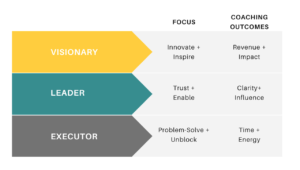By productivity, I mean the process through which you produce the most valuable output in the least amount of time. There’s no doubt you produce plenty of output; most of the time, the real challenge is with the “most valuable” part.
Usually, when we think about improving our productivity, we immediately think of ways to get more organized, stick to routines, identify the best tools, set up new prioritization processes and develop plans. These are all solutions with great potential. But you can’t just throw any solution at any problem and expect it to stick. Rather, the first step to designing a sustainable solution to your lack of productivity is to understand the underlying problem.
More specifically, you must start by identifying what is actually blocking you from prioritizing and producing your most valuable output. The most common blocks to productivity are:
Once you understand which blocks are getting in the way of a particular task or goal, then you can choose the tools or tactics that are most likely to produce the best results.
Lack of Clarity
Whenever you hear yourself or someone on your team make statements like “I need to quit my job in order to achieve ” or “That would be a full-time job!” there’s a good chance that lack of clarity is at play. Lack of clarity often masquerades as lack of time. In practice, this is what it looks like: we block off an hour for a task, and then reschedule that work hour repeatedly when other things come up. At the surface, it may look like we simply can’t prioritize the goal because we are spread too thin, and constantly fighting fires that are outside of our control. But the truth is, underneath, we are choosing a narrative of victimhood and allowing it to drive our actions.
Between the lines, this narrative allows us to believe that (a) we have no control over our schedule and that (b) the goal is physically impossible. These are self-fulfilling thoughts. But it is within our power to recognize these thoughts simply as a signal that we need more clarity on the task.
Clarity exists when we have a very specific short term goal driven consciously or unconsciously by a longer term vision. When we set aside one hour to work, we’re less likely to postpone or deprioritize that work if we know exactly what we plan to do in that hour. But if that plan is hazy, it usually indicates that the longer term vision is unclear.
The best way to get clarity on what we need to do today is to first get clarity on where we want to be in the future, let’s say 6 months. Working backwards from there (3 months, 1 month, 2 weeks, 1 week, today), we will eventually have a specific next step to take. The purpose of this exercise is not to come up with and stick to 6 months of stress-inducing milestones. It is simply to unblock us now so that we will prioritize important work today. Clarity gets the ball rolling on our most valuable output.
Lack of Boundaries
When we have clarity on a task, it becomes a natural priority. The other most common quality of an easy-to-prioritize task is urgency. Urgency simply implies that someone, somewhere is depending on us. However, just because someone is depending on us doesn’t automatically imply urgency. It is when we assume that dependency implies urgency that we have trouble setting boundaries on our own time.
The challenge is in understanding when a dependency is truly urgent. Two thought patterns can lead to a false sense of urgency. The first is when we apply our own meaning to someone else’s actions or words and treat it as evidence of urgency. For example, “He emailed me after work hours so he must be blocked on me” or “Her message was just a one-liner, she must be annoyed that I haven’t submitted it yet.” This sort of inner dialogue can lead to an overwhelming sense of pressure and guilt. While these interpretations might hold some truth, they could also just as easily be false. The next time you notice this thought pattern, try challenging it – “maybe he’s emailing me at night because he’s catching up after a busy day” or “maybe she was multitasking when she messaged me.” Ultimately, the only way to find out the truth is to communicate directly with the person depending on us, both to understand their needs as well as make our own limitations clear. Thinking through multiple interpretations can ease the pressure and help us feel more comfortable engaging in that dialogue.
The second type of thought pattern is when we perceive a situation as a problem, and one that only we can solve. Many of us identify as problem-solvers, and are good at it – we find satisfaction in solving a problem. The difficulty, though, is when we bite off more than we can chew, and feel overwhelmed. To strike a balance, it’s important to turn our focus to the thought patterns that lead us to judging a situation as a problem in the first place, and ask ourselves – what if the problem we are setting out to solve isn’t a problem at all, but rather, an opportunity?
By shifting to an opportunity mindset, we can release our stress-inducing thoughts and feelings, and then decide on a new course of action. Our action might be to set boundaries and protect our own time by not pitching in to fix the problem, thereby creating opportunities for others to learn and grow from the situation. Or it might be to change our mindset about the situation so that we are motivated to help because it serves us and our important work, rather than detracts from it. The choice to set and honor boundaries is ours, and opportunities exist wherever we choose to draw them.
Fear of Failure or Success
Sometimes the thought or mention of a task or goal brings up an intense emotion. For example, we might feel overwhelmed by dread when we think of it, or get unexpectedly annoyed or defensive when someone else brings it up. Or we might experience the opposite, a wave of relief when we find a valid excuse not to do something.
However they show up, intense emotional responses are usually a signal that fear is lurking under the surface.
We experience fear around tasks in two ways:
- Fear of failure to meet our own or another’s expectations
- Fear of success, or more specifically, of the attention, visibility, or increased responsibility and expectations that come along with success
Recognizing our emotional reaction as fear is the first step to moving past it. Just like with boundaries, fear originates in the thoughts that we tell ourselves about a given task.
Our fear narrative can be based on our beliefs about the world and how things work, our perceptions of what others believe or feel, our past experiences, or our own deep-rooted self-doubt. When we lead with this narrative, we feel anxiety, worry and stress, and are inclined to avoid or postpone important work. Noticing and acknowledging these feelings is the first step toward moving the needle on tasks that scare us. Fear of failure or success is not a warning – but simply a sign that we are challenging ourselves to move outside of our comfort zone. The goal is not to get rid of the fear, but to move ahead with full awareness of its presence.
With intention, we can shift our narrative from one based on fear, to one that is inspiring, motivating and empowering. When we realize we are blocked by fear of failure or success, we can focus on redefining success so that it serves us. This may require effort, but is entirely achievable with the help of any self-reflection tools that work – journaling, meditation, exercise, friends, mentors or a coach. The purpose of these tools is ultimately to remind us that while we cannot always control an outcome, we can always control our openness to learn and grow from whatever happens. While this perspective does not come easily to anyone in any situation, it is always available to everyone.
Lack of Desire
At the surface, it is easy to misconstrue fear of failure or success as the lack of desire to do a specific task. A question I very frequently hear posed by my clients is, “Would I want to do this if I was better at it?”
The way to distinguish lack of desire from fear is by getting clear on our values. Values act as our compass, guiding us toward aligning what we do with what we care most about. A true lack of desire to do something would mean that the task or goal is in direct conflict with our values. For example, a leader who strongly values integrity might have no desire to give a highly visible presentation that oversells the current functionality of their product. Sometimes, simply acknowledging the value conflict releases enough stress to help us “agree to disagree” and power through the task. Other times, we can reframe our thoughts to align with another value – for example, the same leader might also value collaboration, and can turn the presentation into an opportunity to create collaborative partnerships with potential customers that will ultimately develop an even better product.
If the task or goal is in total conflict with all our values, then it is time to question why it is on our plate in the first place. Are there other resources available to do this task instead? What aspects of the situation are in our control and can be changed? How often is this happening? Once we are down this line of thinking, most likely there is another heavier task under the hood that needs to be addressed – perhaps a difficult conversation, transition or strategy – that is blocked by fear, lack of clarity or lack of boundaries. While lack of desire can be a convenient mask for other blocks, it is also a valuable gauge of our overall sense of fulfillment and purpose.
What about the Post-Its?
Once we (1) have identified what’s blocking us from moving forward, (2) have developed clarity on what our next actions are, and (3) have an understanding of how it will serve us, then we can set the intention to make it happen. This is where the tools come in – the lists, boards, hacks, and yes, post-its that help us actually produce output quickly.
When we ignore the blocks, we hold our intention loosely. Even if the task or goal is on a list or scheduled in a calendar, it is easily deprioritized. We might even justify and rationalize this to ourselves or others, and can go weeks (even years) not addressing what we know deep down is important. The only way to consistently get high-value work done consistently and effectively is to start at the root of the problem and work our way up.



